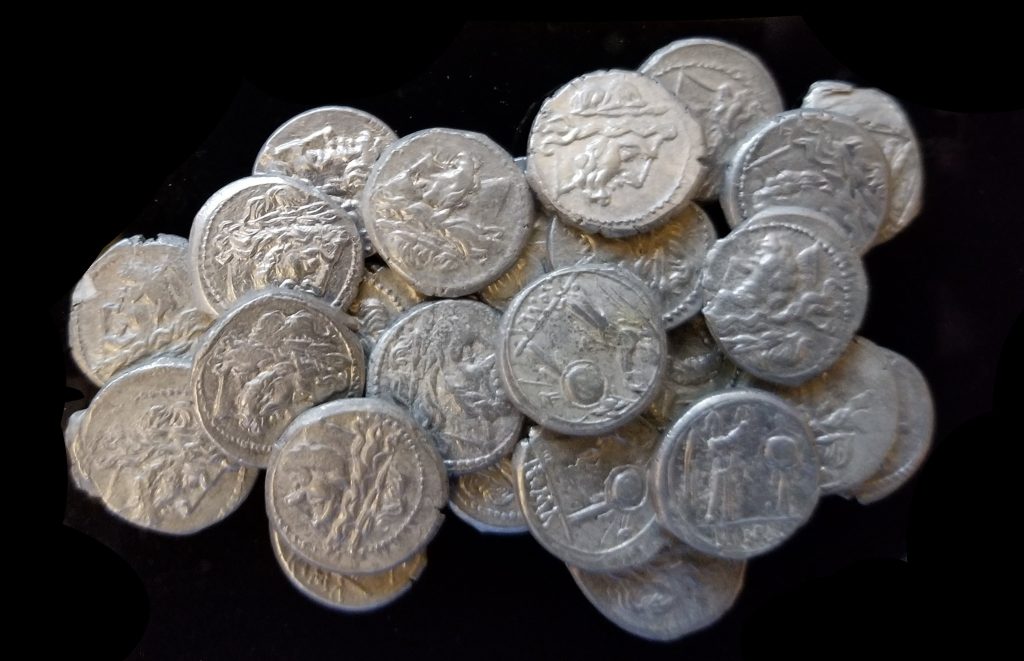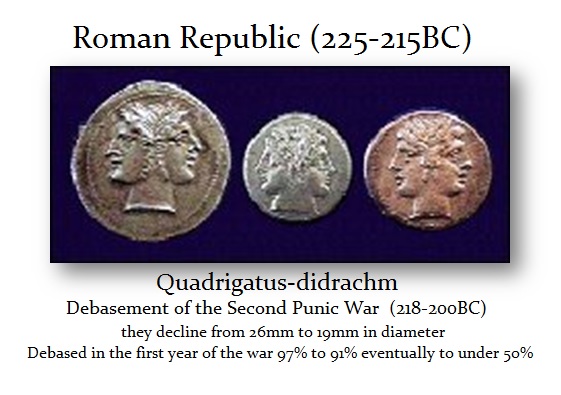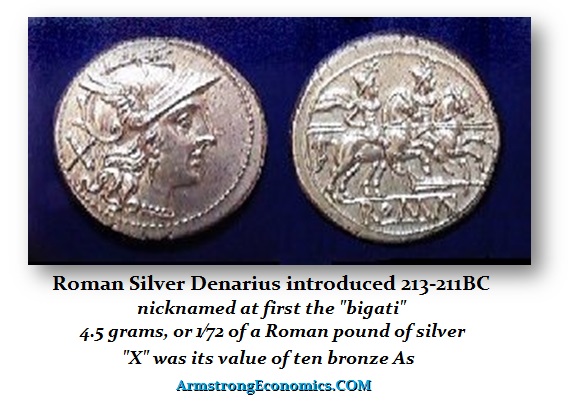Roman Republican Hoard for Sale of Victoriati
Available at the WEC
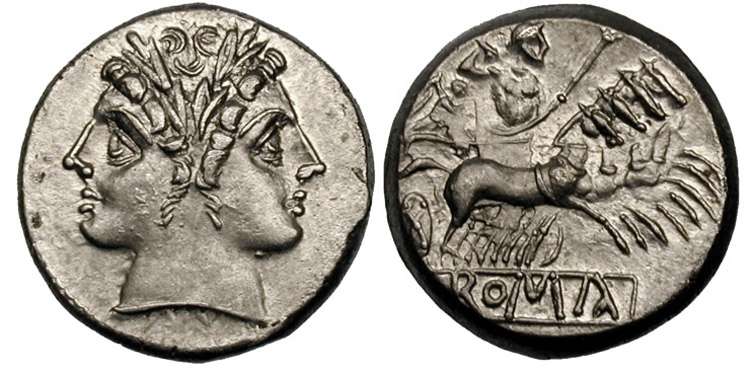 We have another hoard available of the early Roman coinage from the Second Punic War. These are the Greek denominations forming the first two-tier monetary system in the known world. Such hoards are rare today so the opportunities to obtain such specimens are becoming far and few between.
We have another hoard available of the early Roman coinage from the Second Punic War. These are the Greek denominations forming the first two-tier monetary system in the known world. Such hoards are rare today so the opportunities to obtain such specimens are becoming far and few between.
Prior to the introduction of the Roman denarius in about 211 BC, Rome’s silver coins were similar in weight and silver content to the staters (didrachmas) of Greece and Magna Grecia (southern Italy and Sicily). With the Second Punic War (218-200BC), the production of these silver coins greatly increased to cover the expenses as always with war. This demand for coinage was met with the extensive minting of didrachmas known as quadrigati named after the reverse picturing Jupiter driving a four-horse chariot known as the quadriga.
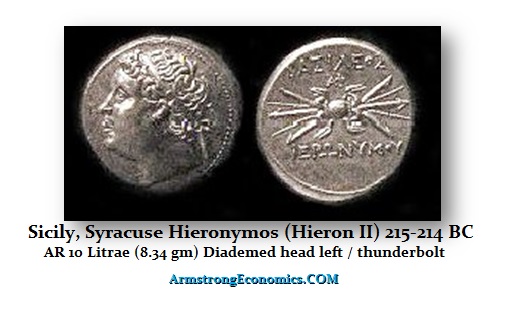 As the Second Punic War drew on, following the demoralizing defeats at Cannae and Trebia, Rome was forced to lower the quadrigati’s weight and fineness thereby debasing the coinage. With the crushing defeat at Cannae in 216BC, the Senate defrayed six months of wages for its legions in Sicily by borrowing money and grain from Hiero II of Syracuse. Many cities in Sardinia made a voluntary contribution in kind (food) to help support the troops.
As the Second Punic War drew on, following the demoralizing defeats at Cannae and Trebia, Rome was forced to lower the quadrigati’s weight and fineness thereby debasing the coinage. With the crushing defeat at Cannae in 216BC, the Senate defrayed six months of wages for its legions in Sicily by borrowing money and grain from Hiero II of Syracuse. Many cities in Sardinia made a voluntary contribution in kind (food) to help support the troops.
 Rome then doubled the land tax the next year to raise money for the war, but that was still insufficient to cover the cost. Rome could not repay Hiero II. Centurians and officers now went without pay and the owner of ships paid the cost of their own crews. This helped to reduce the cost of the war by 20%. Silver was in short supply and the Senate issued heavy bronze coinage to try to pay for costs. This emergency issue only lowered the esteem of Rome in the eyes of many.
Rome then doubled the land tax the next year to raise money for the war, but that was still insufficient to cover the cost. Rome could not repay Hiero II. Centurians and officers now went without pay and the owner of ships paid the cost of their own crews. This helped to reduce the cost of the war by 20%. Silver was in short supply and the Senate issued heavy bronze coinage to try to pay for costs. This emergency issue only lowered the esteem of Rome in the eyes of many.
Some of the last quadrigati weigh less than five grams and are less than 50% silver declining originally from 98%. With Rome’s success in the siege of Syracuse, the wealthiest of the Sicilian cities then under Hannibal’s control, Rome than obtained a large influx of wealth and a supply of silver.
Rome then devalued the coinage and recoined the silver currency in 213/211BC. This was the new lighter weight silver denarius at four scruples (1 scruple equals about 1.12 grams)(4.5 grams) which was tariffed at 10 bronze As and was first nicknamed “bigati” referring to the two horses on the reverse compared to the four on the quadriagtus.
 Nonetheless, the monetary system of Southern Italy and Sicily was still based upon the Greek standard. Rome recognized the continuing need for coins based upon the Greek monetary system that was familiar to the inhabitants of Southern Italy and Sicily. In order to facilitate trade and commerce, the old drachma standard was maintained. Therefore, at roughly the same time, Rome created a second new coin called a victoriatus, struck on a three scruple standard. Victoriati bear the head of Jupiter on the obverse and Victory erecting a trophy on the reverse with ROMA in the exergue. The victoriatus was known among Greek speakers as a tropaikon referring to the trophy on the reverse.
Nonetheless, the monetary system of Southern Italy and Sicily was still based upon the Greek standard. Rome recognized the continuing need for coins based upon the Greek monetary system that was familiar to the inhabitants of Southern Italy and Sicily. In order to facilitate trade and commerce, the old drachma standard was maintained. Therefore, at roughly the same time, Rome created a second new coin called a victoriatus, struck on a three scruple standard. Victoriati bear the head of Jupiter on the obverse and Victory erecting a trophy on the reverse with ROMA in the exergue. The victoriatus was known among Greek speakers as a tropaikon referring to the trophy on the reverse.
While the denarius and its fractions were of a high-grade silver often reaching 98% fineness, the victoriatus was a debased coinage throughout its production c.213-170 BC. It averaged about 70% silver but varied considerably dropping even to 50% at times. It did not display and mark of value as did the denarius displaying “X” meaning ten As. Thus intrinsically a victoriatus was worth roughly half a denarius (75% x 70% = about 50%). But if one didn’t know it was debased and so judged simply by weight, one would have thought it worth 3/4 a denarius (3 scruples compared to 4 scruples). The victoriatus originally weighed about 3.4 grams (3 scruples), meaning that it was half the value of the quadrigatus, a coin weighing 6 scruples that was by this time no longer produced. In hoards, victoriati are almost never found mixed with denarii, but rather by themselves typically in Southern Italy. This indicates its use was restricted to the Greek-dominated regions. The victoriati were struck for about 40 years suggesting that the integration of Southern Italy and Sicily was slow at best to the Latin ways.
All of the victoriati are anonymous baring no name. However many of the later issues bear monograms or symbols that tie them to corresponding companion issues of denarii. The victoriatus was, therefore, a silver coin issued during the Roman Republic from about 221 BC to 170 BC. The obverse of the coin featured the bust of Jupiter and the reverse featured Victory placing a wreath upon a trophy with the inscription “ROMA” in exergue.
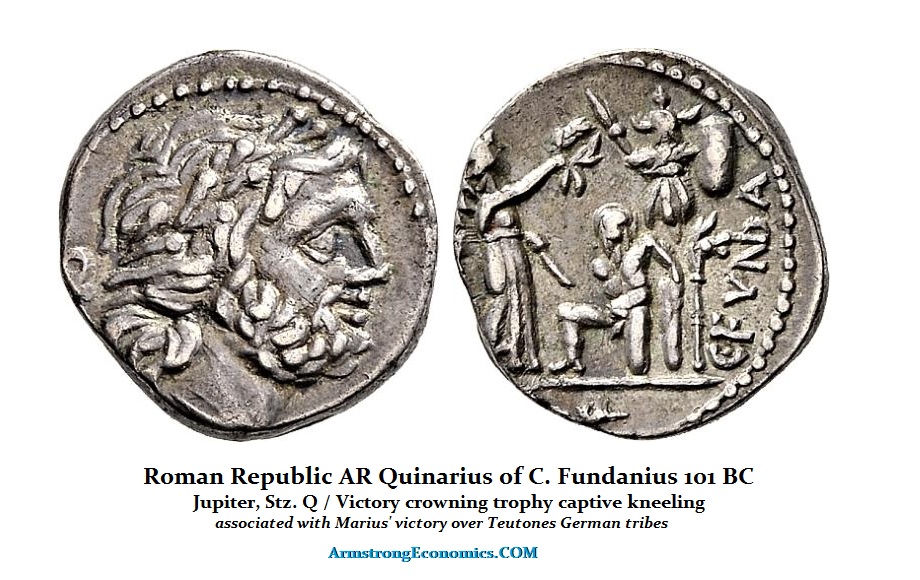 In 101BC, the quinarius was reintroduced in 101 BC with a similar type, but it was valued at 1/2 a denarius. This implies that victoriati may still have been in circulation at this time and were used as only half a denarius. The reintroduced quinarius was produced mainly for Cisalpine Gaul, where the victoriatus and imitations were very popular.
In 101BC, the quinarius was reintroduced in 101 BC with a similar type, but it was valued at 1/2 a denarius. This implies that victoriati may still have been in circulation at this time and were used as only half a denarius. The reintroduced quinarius was produced mainly for Cisalpine Gaul, where the victoriatus and imitations were very popular.
The hoards are typically discovered in limited regions confined to either southern Italy or later Cisalpine Gaul and Spain. This clearly reflects a two-tier monetary system existed during the Roman Republic between the Latin and Greek speaking regions. The victoriatus was generally discontinued around 170 BC, reflecting that the Greek world was being absorbed by the Latin. Therefore, the victoriatus in the marketplace circulated as quinarii.
We have About 200 Victoriati High Quality from a Hoard
Very Fine ………………….. $400
Extremely Fine ………….. $600
Note: After the conference, we have an additional 100 we will make available for online purchase
